Sikhism - Place of worship - Gurudwara
A Gurudwara, meaning "the doorway to God", is the Sikh place of worship and may be referred to as a Sikh temple. In the early days of the Sikh Gurus, before the first gurdwara, followers of Guru Nanak formed a congregation whose venue was known as a dharamśālā (place or seat of religion). A Gurdwara always houses the Sikh holy book, the Guru Granth Sahib and displays a triangular orange flag called the Nishan Sahib.
The Guru Granth Sahib is housed in the main hall known as the Darbar hall. In most modern gurdwaras, the hall is large and will house many hundreds of visitors. Devotees will sit cross-legged on the floor. All those who enter the hall must remove their shoes and cover their heads before entering. On entering the hall, devotees walk slowly and respectfully to the main throne on which the Guru Granth Sahib rests. Devotees then stand before the Holy Scriptures, often say a silent prayer, offer a donation (if able), then bow humbly.
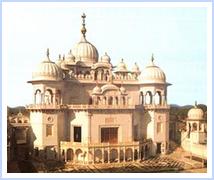 |
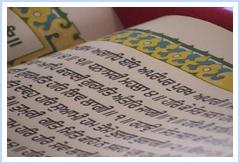 |
The Sikhs treat their Holy Scriptures like a living teacher or guru. This act of respect is not to be taken as an act of worship as Sikhs are only allowed to worship the One God, for which the word in Punjabi is Waheguru. At night, the Guru Granth Sahib is placed in a resting room known as the Sach Khand (which translates to True/Pure Domain/Paradise).
In most — but not all — gurdwaras, men and women typically end up sitting on different sides of the room, separated in the middle by a pathway that leads to the Guru Granth Sahib. Children of either gender may sit on either side. Some Gurudwaras, especially smaller ones, do not have any division.
People of all religious backgrounds or of no religious faith are welcomed into a Sikh Gurudwara. However, it is necessary that any visitors remove their shoes and cover their head with a rumāl before entering the Darbar Sahib. Visitors are also forbidden to go into the gurdwara while they are inebriated or possess alcohol, cigarettes or any intoxicating substances.
Most gurdwaras will have the following important features:
- Nishan Sahib - A triangular orange flag with a Khanda, a Sikh emblem in the middle of the flag. The flag is referred to as a Nishan Sahib - literally meaning Mark or Symbol
- Langar Hall - A large dining room where communal meals are served. Some temples may have tables and chairs but most will expect the devotees to sit on the carpeted floor.
- Darbar Sahib - A hall which houses the SGGS, the Sikh holy book. This hall in most modern temples is large and will house many hundreds of visitors. Devotees will sit cross-legged on the carpeted floor. All those who enter the Darbar Sahib must remove their shoes and cover their heads before entering. The devotees normally on entering this hall will walk slowly and respectfully to the dominant throne on which is placed the SGGS. They then stand before the Holy Scriptures, say silent prayers, offer some coins and then bow humbly before the SGGS. The Sikhs treat their holy Book like a living Teacher or Guru. This act of respect is not to be taken as an act of worship as Sikhs are only allowed to worship the One God, who they call Waheguru.
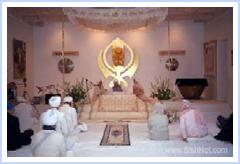
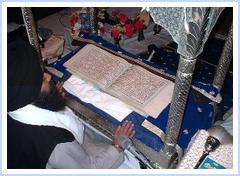
- Sachkhand - A room where the Sikh Holy Book is placed overnight. This room is sometimes called "SachKhand" (which translates to True/Pure Domain/Paradise).
- Various utility rooms, washrooms, kitchen, etc. Some of the larger Sikh temples may also have bedrooms for the devotees to stay overnight with bathroom facilities.
Important gurudwaras run a langar or a free community kitchen for pilgrims, travelers and others. The langar obliterates all distinctions of the rich and the poor, and of caste and creed, and promotes equality, brotherhood and social integration. On a visit to an important shrine, it is an act of piety for a devotee to put in some manual labor in the kitchen, to serve the meals and to take the food, sitting in a row on a mat. The food is traditionally vegetarian. Service of the congregation by all means is highly prized, the more the menial, the more the spiritually edifying. Even well-to-do people would consider it an honor to wipe the dust off the shoes of the devotees, and to sweep up the shrine to imbibe a lesson in humility and service.
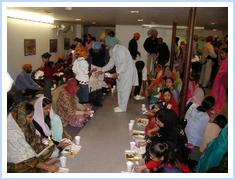
The daily functions
The daily function of a Gurudwara usually begins early in the morning, the exact time is not dictated, in some cases this might be 2 o’clock, in others it might be 10 o’clock. The Guru Granth Sahib would be brought down from the Sachkhand and a ceremony known as the Parkash is performed, this refers to the ‘opening’ of the holy scriptures.

Throughout the day, Gurbani might be read, there would normally be a sevadar in the darbar who serves the Karah Parshad to visitors. The Granthi would be available to read the Hukamnama - the Guru’s command to the visitors. In the evening, the Rahiras Sahib is read aloud and this might typically be followed by kirtan and katha - the translation of shabads and historic/scriptural narration. The evening ends with a ceremony known as the Sukh Asan, during this, the Guru Granth Sahib is closed and laid to rest in the Sachkhand.